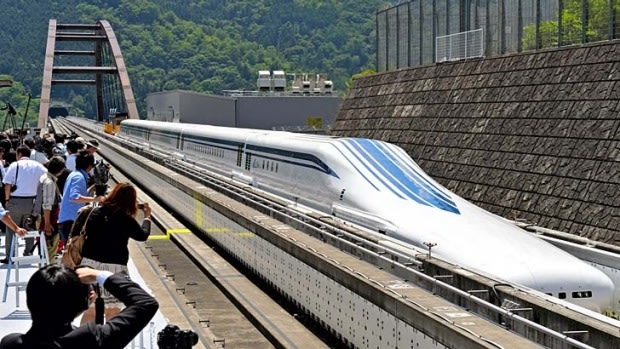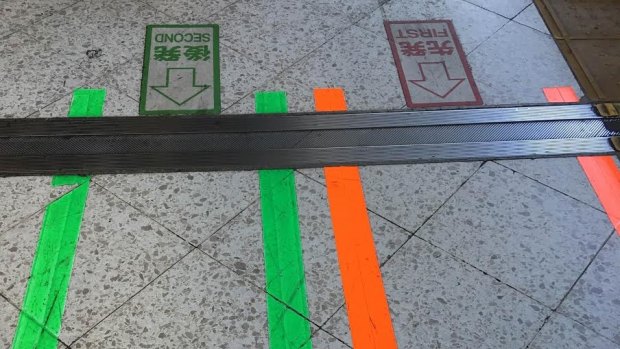This was published 7 years ago
Five things to know about Japan's Shinkansen: The trains that always run on time
By Aisha Dow
In 1964 the Japanese launched the world's first high-speed rail line. With an operating speed of 210km/h, it would still put Australia's "modern" train services to shame.
More than half a century later, the island nation is eager to export its technology to other parts of the world, including Australia. And the key selling points of the Japanese fast train are a matter of great national pride.
1. The Shinkansen always run on time
The average delay of the nation's fleet of bullet train, known locally as the Shinkansen, is less than 60 seconds (eat your heart out Metro Trains). Believe or not, this statistic also includes unavoidable, major delays such as typhoons and earthquakes.
"I think it's fair to say the Shinkansen always run on time," said Nobukazu Nagai, a director with the Japanese Ministry of Land, Infrastructure, Transport and Tourism.
In a requirement that Australians would probably consider – well, embarrassing – Shinkansen drivers are trained to talk to themselves throughout their journey, continually logging how they are performing to schedule. "Ten seconds of delay departure," they will bark out loud, to no one in particular, also pointing with white-gloved hands to a traditional pocket watch that is propped up on the dash.
The Shinkansen can travel many hundreds of kilometres in any one journey, but if a train arrives more than one minute late to its destination, the driver will have to give a formal explanation.
2. Flying trains
The fastest current operating speed of the Japanese bullet train is 320km/h. At this rate, it would possible to travel on land between Melbourne and Sydney in less than three hours.
While Japan no longer has the fastest commercially-operating passenger train on earth (China does at 431km/h), it's attempting to win back the crown, with a new type of super-fast train, perhaps better described as an aeroplane train.
For most of its journey, the magnetic levitation train does make contact with the ground, but hovers 10 centimetres above as it's propelled through the air with electrically-charged magnets on either side of the track. Just like a plane, its wheels go up when it gets up enough speed.
The Central Japan Railway Company has begun construction on a $65 billion magnetic levitation line between Tokyo and Nagoya. SC Maglev trains on this route, expected to be in operation by 2027, will have operating speeds of 500km/h, though trains on a test line near Mount Fuji have already reached more than 600km/h, breaking world speed records in the process.

The Maglev test track in Japan.Credit: Getty Images
Hypothetically, a magnetic levitation train could transport passengers from Melbourne to the Gold Coast in less than four hours. Similar technology is already in operation in Shanghai, China.
3. 51 years accident free
No passenger has been killed in a Japanese bullet train crash since they first rolled out more than half a century ago. Type "Shinkansen crash" into Google and you'll only find a few scraggly stories about a Japanese bullet train that hit a car, killing the driver, and some accounts of the not-uncommon cases of suicide by train. Elsewhere in the world hundreds of people have been killed in high-speed rail catastrophes. Germany's Intercity Express had an unblemished fatality record for just seven years before 101 people were killed when one of its trains derailed at 200km/h in 1998.
4. The seven-minute miracle
No one who visits Japan, especially from a primitive train nation such as Australia, would dispute that the Shinkansen are impressive machines. If you're lucky enough to witness a long-nosed Shinkansen roaring through a station at full speed, you will experience the monstrous roar it makes that rattles you to the bones, and can only evoke comparisons to some sort of mythical being.
But so much of the success of the Japanese fast train and their efficiency is tied to the Japanese themselves.
For example, even the passengers exhibit a special type of discipline. Alongside the trains there are lines painted on the ground, one column labelled "first" for the next train and the other "second" for one after. Instead of lounging wherever they so please on the platform, everyone politely lines up in order of arrival within the appropriate painted line.

The painted lines on the floor of a Japanese train station instructing passengers where to wait.Credit: Aisha Dow
Then there is the so-called "seven-minute miracle", named after the efficient train cleaners who wait in lines beside the train. Wielding squeegees, the women in pink and men in blue will bow deeply to the train as it arrives and then bow repeatedly to all the passengers who disembark, before running through the cabins, wiping down trays and collecting rubbish. All this takes just seven minutes, allowing the Shinkansen to quickly turn around for another major journey.
5. Better than air travel? In the battle between the Shinkansen and the airlines, the Japanese talk about the magic 800-kilometre mark. Any less than 800 kilometres, most prefer to travel by fast train, any more then it is the aeroplanes that have the edge. The distance between Melbourne and Sydney is 870 kilometres, just exceeding that 800 mark. So does that mean that an Australian fast train is doomed to fail? Maybe not, says a representative from the Central Japan Railway Company. "The competitiveness of this section really depends on the location of the Sydney and Melbourne station. If the stations can be located in the city centre, of course this line has a great competitive edge against airport," they said.
Aisha Dow travelled to Japan as a guest of the Ministry of Foreign Affairs of Japan.
See also: Japan's bullet trains just got even better
See also: Japan's bullet trains celebrate 50 years of operation
Sign up for the Traveller Deals newsletter
Get exclusive travel deals delivered straight to your inbox. Sign up now.